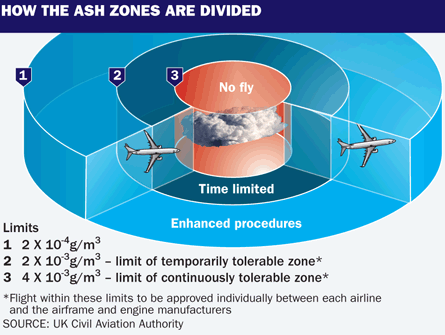The atmospheric volcanic ash densities cleared as safe for flight in UK and Irish airspace have been officially doubled. Airspace regulators predict there will probably be room for further extension of "safe" contamination levels following more research into aeroengine and airframe damage tolerance.
This will mean fewer airspace closures, says the UK Civil Aviation Authority, because it has been established, working with original equipment manufacturers, that damage tolerance to atmospheric ash is higher than originally estimated.
But the CAA adds that it is proceeding on a scientific basis as more data is gathered, and has rejected the "suck it and see" approach that it implies is being adopted by some European agencies. The CAA says the UK and Ireland "could not wait" for pan-European agreement on new parameters because their airspace is closer to Eyjafjallajökul, the Icelandic volcano that is producing the ash and has resulted in more frequent and extensive airspace closure than in the European mainland.
Although the UK CAA has authorised flight in airspace with double the density of ash contamination than previously permitted, it has laid the onus of individual risk assessment firmly on all operators, requiring each to work with the manufacturers of its aircraft fleet and engines to confirm that they agree their equipment is able to tolerate the new limits.
 |
|---|
Having done that, the operators have to present the assessment to the CAA before winning approval to enter denser areas of ash than is now allowed.
The new parameters, which divide ash-contaminated airspace into three zones according to the density of ash, are still "conservative", says the CAA, adding that it considers this to be "stage 2" in a process of testing and analysis that may lead to further stages.
The three zones (see above) are designated no-fly, time-limited and enhanced procedures. Airspace outside the enhanced procedures zone is designated "normal".
This contrasts with the CAA's "stage 1" decision, announced on 19 April following five days of airspace closure, which declared a no-fly zone surrounded by an enhanced procedures zone, with a 60nm (111km) buffer zone outside those to allow for errors in ash drift calculations. With the stage 2 definitions, there is no buffer zone.
Meanwhile, the European Aviation Safety Agency has not delivered a ruling on flight in the presence of atmospheric ash contamination, but says it is "working with ICAO on establishing certification standards for ash concentration".
The agency adds that since this requires thorough analysis and testing, specific limits are not expected to be announced for a few months. EASA says: "We will work with the European Commission, Eurocontrol and national aviation authorities towards a co-ordinated approach to defining rules for flying in airspace with low ash densities."
At present, although the European authorities are exchanging information on the ash situation, they are not co-ordinating their responses. The UK and Irish aviation authorities, however, admit they are more highly motivated to find solutions and quantify them than the rest of Europe, because they are worse affected than the mainland.
The UK CAA, on 18 May after releasing its new parameters for zoned airspace closure, said it "could not wait" while the EU national authorities discussed the merits of its decision, which it had reached following discussions with airframe and engine manufacturers, EASA, and the US Federal Aviation Administration.
Source: Flight International



















